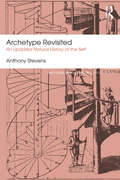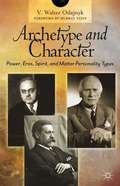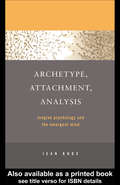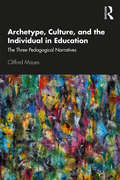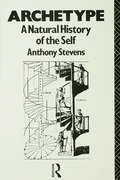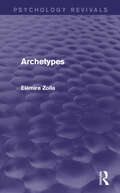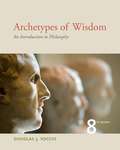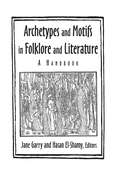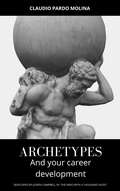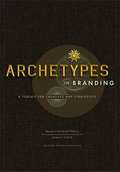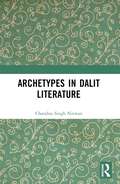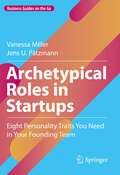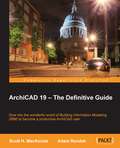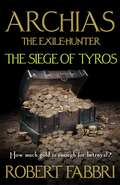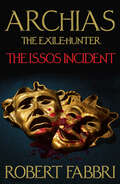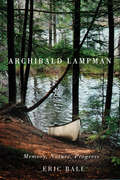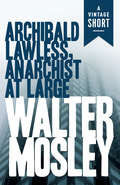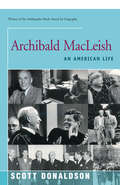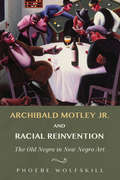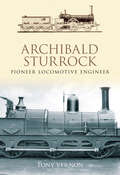- Table View
- List View
Archetype
by M. D. WatersIntroducing a breathtakingly inventive futuristic suspense novel about one woman who rebels against everything she is told to believe. Emma wakes in a hospital, with no memory of what came before. Her husband, Declan, a powerful, seductive man, provides her with new memories, but her dreams contradict his stories, showing her a past life she can't believe possible: memories of war, of a camp where girls are trained to be wives, of love for another man. Something inside her tells her not to speak of this, but she does not know why. She only knows she is at war with herself. Suppressing those dreams during daylight hours, Emma lets Declan mold her into a happily married woman and begins to fall in love with him. But the day Noah stands before her, the line between her reality and dreams shatters. In a future where women are a rare commodity, Emma fights for freedom but is held captive by the love of two men--one her husband, the other her worst enemy. If only she could remember which is which. . . . The first novel in a two-part series, Archetype heralds the arrival of a truly memorable character--and the talented author who created her. Look for Prototype, the second novel from M.D. Waters, coming July 2014.
Archetype Revisited: An Updated Natural History of the Self (Routledge Mental Health Classic Editions #Vol. 105)
by Anthony StevensArchetype: A Natural History of the Self, first published in 1982, was a ground-breaking book; the first to explore the connections between Jung's archetypes and evolutionary disciplines such as ethology and sociobiology, and an excellent introduction to the archetypes in theory and practical application as well. C.G. Jung's 'archetypes of the collective unconscious' have traditionally remained the property of analytical psychology, and have commonly been dismissed as 'mystical' by scientists. But Jung himself described them as biological entities, which, if they exist at all, must be amenable to empirical study. In the work of Bowlby and Lorenz, and in studies of the bilateral brain, Anthony Stevens has discovered the key to opening up this long-ignored scientific approach to the archetypes, originally envisaged by Jung. At last, in a creative leap made possible by the cross-fertilisation of several specialist disciplines, psychiatry can be integrated with psychology, with ethology and biology. The result is an immensely enriched science of human behaviour. In Archetype Revisited, Stevens considers the enormous cultural, social and intellectual changes that have taken place since the publication of the original edition, and includes: - An updated chapter on The Archetypal Masculine and Feminine, reflecting recent research findings and developments in feminist thinking; - Commentary on the intrusion of neo-Darwinian thinking into psychology and psychiatry; - Analysis of what has happened to the archetype in terms of our understanding of it and our responses to it. This Classic Edition of the book includes a new introduction by the author.
Archetype and Character
by V. Walter OdajnykIntroducing a new typology based on Power, Eros, Matter and Spirit as the motivations that define human attitudes and behaviour, the book outlines eight personality types based on the extraverted and introverted deployment of the four drives and applies these typological categories to Freud, Adler and Jung.
Archetype, Attachment, Analysis: Jungian Psychology and the Emergent Mind
by Jean KnoxArchetype, Attachment, Analysis is a well-researched presentation of new material that offers a revision and reinterpretation of Jung's archetypal hypothesis. The author's ground breaking new exploration of expanding knowledge from other disciplines such as cognitive science and developmental psychology, and attachment theory and research evidence sheds important new light on Jungian theory and practice. Using information gathered through laboratory investigations and natural observational studies Jean Knox brings the notion of archetypes up to date and considers the implications of new paradigms for clinical work with patients. This book will become essential reading for all professionals and students of analytical psychology.
Archetype, Culture, and the Individual in Education: The Three Pedagogical Narratives
by Clifford MayesIn Archetype, Culture, and the Individual in Education: The Three Pedagogical Narratives, Clifford Mayes presents a unique approach to understanding how Jungian principles can inform pedagogical theory and practice. In a time when what the educational historian Lawrence Cremin called the 'military-industrial-educational complex' and its standardized education are running roughshod over the psyche and spirit of students, Mayes deploys depth psychology, especially the work of Jung, to advance an archetypal approach to teaching and learning. Mayes demonstrates how catastrophic it is to students when the classroom is governed by forces that objectify the individual in a paralysing stranglehold. He argues that one’s life-narrative is significantly impacted by one’s narrative as a learner; thus, schooling that commodifies learning and turns the student into an object has neuroticizing effects that will spread throughout that student’s entire life. In Part I, Mayes explores the interaction between archetypes and various types of time—ultimately focusing on the individual but always mediated by ‘the cultural unconscious’. In Parts II and III, he brings together education with (post-)Jungian and (post-)Freudian psychology, examining transference/countertransference in the classroom; the Jungian idea of ‘the shadow’ applied to educational processes; Jung’s unique vision of ‘the symbol’ and its importance for educational theory; and Jung’s ‘transcendent function’ as a prime educational modality. Mayes concludes by looking to the future of archetypal pedagogy. This groundbreaking work in the emerging field of Jungian pedagogy is invaluable reading in Jungian Studies, depth psychological theory, educational theory, and for teachers and psychotherapists.
Archetype: A Natural History of the Self (World Library Of Mental Health Ser.)
by Anthony StevensCommonly dismissed as mystical by scientists, archetypes were described by Jung as biological entities, which have evolved through natural selection, and which, if they exist at all, must be amenable to empirical study. Anthony Stevens has discovered the key to opening up this long-ignored scientific approach to the archetype.
Archetypes (Psychology Revivals)
by Elémire ZollaMan is dominated by his archetypes; they mould not only his history but his dreams. But how are we to define and evaluate them? Is it perhaps possible for us to relate more creatively to them? Originally published in 1981, these are some of the questions raised by this title. To answer them the author gathered together a vast amount of material drawn from Eastern and Western traditions, from science, literature, art and poetry. The answers he puts forward are often highly original and will surely challenge many of our most cherished patterns of thought. There emerges from this book what can only be described as a global metaphysical system, yet the author’s language is not that of an ordinary metaphysical treatise, and what he writes offered new challenge and hope to those suffering from the despair and cynicism engendered by a great deal in modern society at the time. Zolla does not, however, advocate a return to earlier historical patterns, nor is he proposing a new Utopia, but rather offers us a brilliant series of lessons in the art of centring. In the words of Bernard Wall, writing in the Times Literary Supplement, Zolla’s ‘deep, polymathic probing of the terms of human existence makes it sensible to compare him with Simone Weil, while some of his conclusions about ultimate mysteries – expressed in signs, symbols and sacraments, the sense of which we have lost – will make us think of the later T. S. Eliot’.
Archetypes Of Wisdom: An Introduction To Philosophy
by Douglas SoccioARCHETYPES OF WISDOM: AN INTRODUCTION TO PHILOSOPHY, 8E brings philosophy to life through lively narratives, engaging illustrations, and a student-friendly writing style. Using its signature conversational prose, the textbook guides students through the lives and works of history's greatest philosophers, then brings it all together with helpful study materials in every chapter. Drawing from both canonical primary sources and the latest philosophical critiques, ARCHETYPES OF WISDOM: AN INTRODUCTION TO PHILOSOPHY, 8E makes philosophy approachable and exciting for students.
Archetypes and Motifs in Folklore and Literature: A Handbook
by Jane GarryThis is an authoritative presentation and discussion of the most basic thematic elements universally found in folklore and literature. The reference provides a detailed analysis of the most common archetypes or motifs found in the folklore of selected communities around the world. Each entry is written by a noted authority in the field, and includes accompanying reference citations. Entries are keyed to the Motif-Index of Folk Literature by Stith Thompson and grouped according to that Index's scheme. The reference also includes an introductory essay on the concepts of archetypes and motifs and the scholarship associated with them. This is the only book in English on motifs and themes that is completely folklore oriented, deals with motif numbers, and is tied to the Thompson Motif-Index. It includes in-depth examination of such motifs as: Bewitching; Chance and Fate; Choice of Roads; Death or Departure of the Gods; the Double; Ghosts and Other Revenants; the Hero Cycle; Journey to the Otherworld; Magic Invulnerability; Soothsayer; Transformation; Tricksters.
Archetypes and Your Career Development
by Claudio Pardo MolinaIn your work experience you have come to the conclusion that values and ancient wisdom have become more necessary today than ever. A large part of the current problems come from ethical problems that are drawn from the past and from the depth of the contradictions of the human being. Claudio Molina's book tries to bring to present ancient wisdom both from the east and the west. Hoping that this knowledge can help us answer these endless self-existence doubts. Where do we come from? Who are we? Where do we go?
Archetypes in Branding
by Joshua C. Chen Margaret HartwellCommunication. Authenticity. Creativity. Tomorrow's brands will be defined by their interactions and relationships. Customers are demanding greater accountability from businesses. Workers are craving a deeper sense of meaning from their careers. And companies are continually seeking ways to achieve more powerful and resonant brand engagements. Archetypes in Branding: A Toolkit for Creatives and Strategists offers a practical tool for satisfying these needs. Using a highly participatory approach to brand development, and combined with a companion deck of sixty original archetype cards, this kit gives you the tools you need to: Reveal your brand's motivations, how it moves in the world, what its trigger points are and why it attracts certain customers Forge relationships with the myriad stakeholders that affect your business Empower your team to access their creativity and innovate with integrity C.G. Jung describes archetypes as "pieces of life itself-images that are integrally connected to the individual by the bridge of emotions." Applying archetypes helps bridge the gap between the cognitive and intuitive sides of the brain and between internal and external business objectives. Archetypes in Branding takes you through a fascinating exploration of the important role archetypes have played in mythology and psychology-and now in business-to resolve brand inconsistencies and enhance trust with all stakeholders.
Archetypes in Dalit Literature
by Chandna Singh NirwanArchetypes in Dalit Literature examines the role of the multitudinous archetypes and myths in understanding the evolution of the psyche and consciousness of the Parayar Dalit community based out of Tamil Nadu, India. This book also examines the other Dalit communities like Bhangis, Chuhras and Madigas through the lens of Archetypal criticism. This is a nuanced take on Dalit Studies where Western thought and theory have been applied to the colossal work of a Tamil Dalit writer, Bama and others (Mulk Raj Anand, Omprakash Valmiki, Sharankumar Limbale and Perumal Murugan) to comprehend the community archetypal characters, setting, myths, rituals, and language. A detailed analysis of the Jungian archetypes of Rebirth, Mother, Spirit and Trickster has helped in acquiring an understanding of the so-called lower caste, their circumstances, their life and experiences. Among the seminal works on myth criticism are Joseph Campbell's ‘Monomyth’ and Vladimir Propp's ‘Functions’. One of Bama’s works, Vanmam (2008) largely adheres to these structures which makes it a good example of fiction based on reality and thereby, also making it at par with the mainstream Indian Writing in English. Chandna has also analyzed the significance of community myths, stories, and folklore using the concept of implicit mythology. This book also studies the Dalit language as a special case and unfolds various meanings about the culture, community, and people in context. An important finding is that the language of marginalization is very much a reality. Bama’s narratives are true representations of the journey of the Parayar Dalit identity formation and the changes it has undergone over time. The study of the different aspects of the lives, ideologies, and culture of the marginalized section of Indian society as represented by these writers in their works has enhanced the understanding of their significant role and contribution to Indian society which may not have, over time been acknowledged, yet undeniably needs to be appreciated and celebrated.
Archetypes of Thought
by Thomas MolnarIn Archetypes of Thought, originally published in 1991 with the title Philosophical Grounds, Thomas Molnar follows seven basic themes of Western philosophical speculation from their development in the earliest times of systematic thought through their evolution through the centuries and civilizations to the present. Some of the themes are origin and its reflection, guilt of being, one and the multiple, the temptation of mechanization, and nocturnal man. The book is neither a chronological treatment of issues nor a list of philosophical schools and movements. Rather, it reaches for the archetypes of philosophical reasoning. Molnar shows the presence of modern themes in the entire history of thinking, traces technology to the first stirrings of rationalism, and evinces modern man's feeling of culpability. Throughout, the soul is perceived as the keeper of God's and man's secret, one which reflects reality and also tries to organize it according to an ontologically implanted rhythm. In his new introduction, Molnar explains and re-examines his reasons for writing the book. While the themes he covers have been widely dealt with in contemporary thought, they are brought together to form an original combination of philosophical concepts. Archetypes of Thought is an intriguing study of the evolution of philosophical thinking. It is essential reading for both students and professionals of philosophy, history, and sociology.
Archetypes of Wisdom: An Introduction to Philosophy
by Douglas SoccioFeaturing lucid and conversational prose and a well-chosen, reader-friendly array of succinct excerpts from canonical primary sources, ARCHETYPES OF WISDOM: AN INTRODUCTION TO PHILOSOPHY, 7E brings philosophy to life for readers. Extremely reader friendly, this test examines philosophies and philosophers while using numerous pedagogical illustrations, special features, and an approachable page design to make this oftentimes daunting subject more engaging. The Seventh Edition represents a careful revision, focused on enhancing the book's reader-praised "search for wisdom" motif. This edition is supported by an unmatched array of teaching and learning resources including an online resource center with dynamic, easy-to-use lecture and class preparation tools.
Archetypes: Who Are You?
by Caroline MyssHave you ever wondered why you are drawn to certain people, ideas, or products and turned off by others? Are you constantly searching for something you can't put your finger on, or wondering whether you are living a life that truly fits? In Archetypes: Who Are You?, New York Times best-selling author Caroline Myss delves into the world of archetypes, which have been the subject of her work for more than 25 years. Archetypes are universal patterns of behavior that, once discovered, help you better understand yourself and your place in the world. In short, knowing your archetypes can transform your life. Within the pages of this book, Myss writes about ten primary feminine archetypes that have emerged in today's society: the Caregiver, the Artist/Creative, the Fashionista, the Intellectual, the Rebel, the Queen/Executive, the Advocate, the Visionary, the Athlete, and the Spiritual Seeker. In each chapter, she explains one individual archetype, showing how it has evolved and then in fascinating detail lays out the unique characteristics, the defining graces, the life challenges, and other information to help you understand if you are part of this archetype family and if so, how you can fully tap into its power. She also offers tips and practical advice on how to fully engage with your archetypes. Learning which archetypes best describe you is just the beginning. You can then use this knowledge to make more conscious decisions about everything from careers to relationships, avoiding common pitfalls of your personality type while playing up your strengths. The result is a happier, more authentic you. It's never too late to change your life by embracing your archetypes to the fullest. So are you a Rebel? An Artist? A Visionary? Join us . . . and find yourself.
Archetypical Roles in Startups: Eight Personality Traits You Need in Your Founding Team (Business Guides on the Go)
by Vanessa Miller Jens U. PätzmannFounding a startup is a challenging endeavor that works best in a well-balanced team. Different thinking styles are needed throughout the founding journey. Archetypes are deeply engrained templates in the collective unconscious and can be used to reveal the hidden aspects of social interactions within teams. This book employs an archetypical personality test to uncover the eight most significant team roles needed in a startup: the leader, the mentor, the artist, the friend, the hero, the femme fatale, the rebel and the manager. The artist, for example, always finds unconventional solutions, the femme fatale attracts support for the idea, and the hero is undaunted in the face of setbacks. Archetypical roles can manifest in individuals or at the group level, and they can and should change throughout the journey. With the included personality test, this book offers entrepreneurs, investors and mentors alike a tool to improve the interpersonal processes in startup teams.
ArchiCAD 19 – The Definitive Guide
by Scott H. Mackenzie Adam RendekThis book is for architects, architectural technicians, and construction professionals who are familiar with 2D CAD programs such as AutoCAD Lite, or have some exposure to a 3D BIM package such as Revit. No experience with ArchiCAD is required. If you want to learn the skills needed for architectural drawing production in the real world, then this book is for you.
Archias the Exile-Hunter - The Siege of Tyros (Alexander’s Legacy)
by Robert FabbriArchias the Exile-Hunter: The Siege of TyrosArchias, struggling actor turned assassin, is finally out of luck. Alexander the Great has been informed of Archias' latest victim's death, and that it was his gold that was used to pay for the murder. Locked up awaiting Alexander's judgement, Archias believes his days are numbered.Instead, Alexander gives him a new mission: infiltrate the island city of Tyros, currently under siege, kill the soldiers who are delaying Macedon's victory, and hold the King of Tyros captive until Alexander arrives. But Alexander makes no mention of Archias' fate, should he succeed in this almost impossible task - a task more like a suicide mission in fact. Can Archias win through, and make it out alive?
Archias the Exile-Hunter: An Alexander's Legacy Novella (Alexander’s Legacy)
by Robert FabbriAn Archias the Exile-Hunter short storyArchias, struggling actor, quick on his feet and even faster with his words, is at the end of his luck. Having escaped to Rhosos, on the edge of Macedon's territory, to evade the threat of the debt collectors, he has been prevented from going any further by the arrival of Alexander the Great's mighty army. And with it, those very same debt collectors.So when the chance is given to him to earn enough money to be rid of his pursuers forever, he has to take it. Even if it means risking life and limb by attempting the most crazy of rescues - to bring back a kidnapped boy from inside the camp of Darius, King of Kings of the crumbling Persian empire. A camp that is on the eve of battle... As Alexander's troops draw nearer, and Darius's cavalry begin their war-cry, can Archias save himself, the boy, and his fellow rescuers, before it's too late?
Archibald Lampman
by Eric BallTreasuring the past, savouring the present, and wanting to do right by the future, Archibald Lampman was a poet keenly focused on the workings of time. He was also a thinker of mystical predisposition. His goal was not to transcend time, but to find redemptive meaning within it. Archibald Lampman: Memory, Nature, Progress explores the ways in which Lampman pursued this goal in relation to the three faces of time. Memory fascinated Lampman. He relished the "alchemy" by which the dross of past experience could be left behind and the gold preserved. Nature compelled his mind and emotions, and his clear-eyed observations of both countryside and wilderness settings gave rise to a self-evolved poetics of inclusiveness. In his celebrations of nature in all its manifestations, mild or bleak, he anticipated the work of iconic Canadian painter Tom Thomson and he forecasted the environmentalism of our own time. Progress for Lampman spelled societal rectification. By forwarding the cause of social betterment, one was part of a movement larger than oneself, and this expansion, too, was redemptive. Archibald Lampman: Memory, Nature, Progress is the first book on this foundational figure in Canadian literature to appear in over twenty-five years and the first thematically focused study. Combining close analysis with biographical context, it shows how Lampman's oeuvre was shaped by his responses to his physical surroundings and to his social-intellectual milieu, as filtered through his stubbornly independent outlook.
Archibald Lampman: Memory, Nature, Progress
by Eric BallTreasuring the past, savouring the present, and wanting to do right by the future, Archibald Lampman was a poet keenly focused on the workings of time. He was also a thinker of mystical predisposition. His goal was not to transcend time, but to find redemptive meaning within it. Archibald Lampman: Memory, Nature, Progress explores the ways in which Lampman pursued this goal in relation to the three faces of time. Memory fascinated Lampman. He relished the “alchemy” by which the dross of past experience could be left behind and the gold preserved. Nature compelled his mind and emotions, and his clear-eyed observations of both countryside and wilderness settings gave rise to a self-evolved poetics of inclusiveness. In his celebrations of nature in all its manifestations, mild or bleak, he anticipated the work of iconic Canadian painter Tom Thomson and he forecasted the environmentalism of our own time. Progress for Lampman spelled societal rectification. By forwarding the cause of social betterment, one was part of a movement larger than oneself, and this expansion, too, was redemptive. Archibald Lampman: Memory, Nature, Progress is the first book on this foundational figure in Canadian literature to appear in over twenty-five years and the first thematically focused study. Combining close analysis with biographical context, it shows how Lampman’s oeuvre was shaped by his responses to his physical surroundings and to his social-intellectual milieu, as filtered through his stubbornly independent outlook.
Archibald Lawless, Anarchist at Large
by Walter MosleyA Vintage Shorts "Short Story Month" Selection Young journalism student Felix Orlean is in over his head. Against his better judgment, he is temporarily under the employ of the mad yet charismatic anarchist detective Archibald Lawless, a witness to murder, and under investigation for the theft of millions of dollars in red diamonds. Caught in an impossible predicament, Orlean plunges into an underworld populated by shady denizens. With Lawless, he unravels a big-money conspiracy involving cold-blooded assassination, hide-away real estate in Manhattan, a network of international criminals, a lethal siren named Lana Drexel, and the richest man in Canada. A brilliant, absurdist novella and a biting work of political commentary, Walter Mosley's "Archibald Lawless" is a masterpiece of contemporary American crime fiction. An ebook short.
Archibald MacLeish: An American Life
by Scott DonaldsonArchibald MacLeish was the winner of the 1993 Ambassador Book Award for biography.
Archibald Motley Jr. and Racial Reinvention: The Old Negro in New Negro Art
by Phoebe WolfskillAn essential African American artist of his era, Archibald Motley Jr. created paintings of black Chicago that aligned him with the revisionist aims of the New Negro Renaissance. Yet Motley's approach to constructing a New Negro--a dignified figure both accomplished and worthy of respect--reflected the challenges faced by African American artists working on the project of racial reinvention and uplift. Phoebe Wolfskill demonstrates how Motley's art embodied the tenuous nature of the Black Renaissance and the wide range of ideas that structured it. Focusing on key works in Motley's oeuvre, Wolfskill reveals the artist's complexity and the variety of influences that informed his work. Motley's paintings suggest that the racist, problematic image of the Old Negro was not a relic of the past but an influence that pervaded the Black Renaissance. Exploring Motley in relation to works by notable black and non-black contemporaries, Wolfskill reinterprets Motley's oeuvre as part of a broad effort to define American cultural identity through race, class, gender, religion, and regional affiliation.
Archibald Sturrock: Pioneer Locomotive Engineer
by Tony VernonBorn in 1816, by 1840 Sturrock was involved with Brunel and Gooch in establishing the Great Western Railway's works at Paddington and new town at Swindon. On Brunel's recommendation, Sturrock was appointed locomotive engineer for Great Northern Railway, and he designed the locomotives and carriages which established East Coast main line's reputation for comfort and punctuality. He later played a lead role in establishing the Yorkshire Engine Co. In 1863 Sturrock invented the steam tender, the predecessor of the locomotive booster, an auxiliary engine designed to give extra power at starting or at low speeds. Sturrock's later life comprised a lengthy retirement - 43 years - of hunting, shooting and fishing. The slightly ambiguous nature of his taking up retirement just after a costly steam tender failure has also ensured Sturrock a place as a topic for revisionist locomotive historians. Written by his great-great-grandson, Tony Vernon, this intimate biography offers an insight into Sturrock's family life as well as his professional life.

